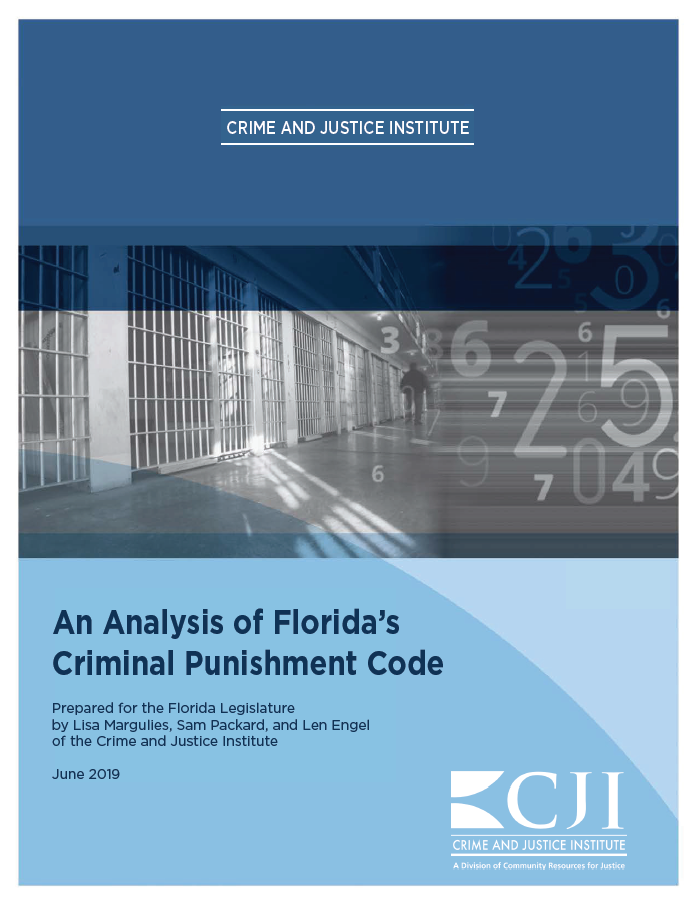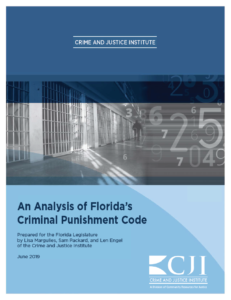

Click here to read the report.
 For over 20 years, the Criminal Punishment Code (CPC) has guided decision‐making on criminal sentencing in Florida. Florida implemented the CPC in 1998 to ensure unbiased, uniform, and proportional sentencing decisions. While rehabilitation is considered a goal of the CPC, the primary purpose of sentencing, as articulated in Florida statute, is punishment.
For over 20 years, the Criminal Punishment Code (CPC) has guided decision‐making on criminal sentencing in Florida. Florida implemented the CPC in 1998 to ensure unbiased, uniform, and proportional sentencing decisions. While rehabilitation is considered a goal of the CPC, the primary purpose of sentencing, as articulated in Florida statute, is punishment.
Until recently, the CPC has undergone little analysis or assessment to understand its impact on Florida’s prison and jail populations. With greater attention on Florida’s sizeable prison population, the continued decline in crime rates statewide, and an abundance of research showing the harmful effects of long periods of incarceration on crime, recidivism, and rehabilitation, policymakers have begun to focus on the role and impact of the CPC. The Crime and Justice Institute (CJI) conducted this analysis to understand the CPC’s impact on prison sentences and lengths of incarceration.
The CPC uses a complex formula that considers a number of factors related to the seriousness of the offense, aggravating circumstances, and prior criminal history. The final CPC score translates to a variety of outcomes: a required state prison sentence for cases exceeding 44 points, absent departure; a range of sanctions, including state prison, for those cases scoring greater than 22 and up to 44 points; and non‐state prison sanctions, with some exceptions, for those cases scoring below 22 points.
This analysis focuses primarily on scoresheets receiving score totals from 22 to 44 points because this group represents a significant portion of overall CPC scoresheets in FY 2018 and the court has broad sentencing discretion in this range. Therefore, this particular category presents the opportunity to analyze variability in sentencing decisions over a large number of cases.
CJI’s analysis of the data in Florida arrived at five key findings for FY 2018:
- Individuals with point totals in the 22 to 44 point range accounted for an estimated 4,500 admissions to prison, or more than 15 percent of overall admissions, in FY 2018;
- The severity of a primary offense in the CPC scoresheet does not correlate with the likelihood of a prison sentence within the 22 to 44 point group;
- The likelihood of a prison sanction for cases receiving 22 to 44 points varies dramatically by judicial circuit and county;
- Sentences in Florida significantly exceed the minimum required prison sentence within the 22 to 44 point group; and
- Exceeding the 44‐point threshold drastically increases the likelihood of a prison sanction.
Since the implementation of the CPC in 1998, volumes of criminological research suggest that treatment and supervision, as opposed to incarceration, have a greater impact on reducing recidivism and victimization, and that public safety can be protected while reducing prison populations. Specifically, this body of research demonstrates that incarceration is not a panacea to public safety concerns and, in many cases, may actually contribute to crime.
Florida’s sentencing policy has not changed for decades despite research indicating it may not be providing the public safety benefits envisioned, and, in fact, its emphasis on punishment may be in conflict with best practice for recidivism reduction. Moreover, the intended goals of the CPC, including proportionality, fairness, and economy, have proven to be elusive.
CJI’s analysis shows an objective and a quantifiable basis for Florida to revisit the CPC’s structure and limitations and to reconsider its goals with a clearer understanding of effective and efficient criminal sentencing policy.
CJI recommends that Florida consider the following policy changes:
- Rely on two primary factors in determining a sentence: criminal history and seriousness of current offense;
- Use a recommended sentence range with lower and upper limits to guide judicial decisions;
- Allow departure from a recommended range only on findings of aggravated or mitigated circumstances in writing and on the record;
- Shorten sentence lengths, given that the 85 percent time‐served requirement is applied to all Florida inmates;
- Implement post‐release supervision for appropriate defendants; and
- Create a meaningful right of appeal to a higher court for sentences that exceed specified ranges.
Click here to read the report.